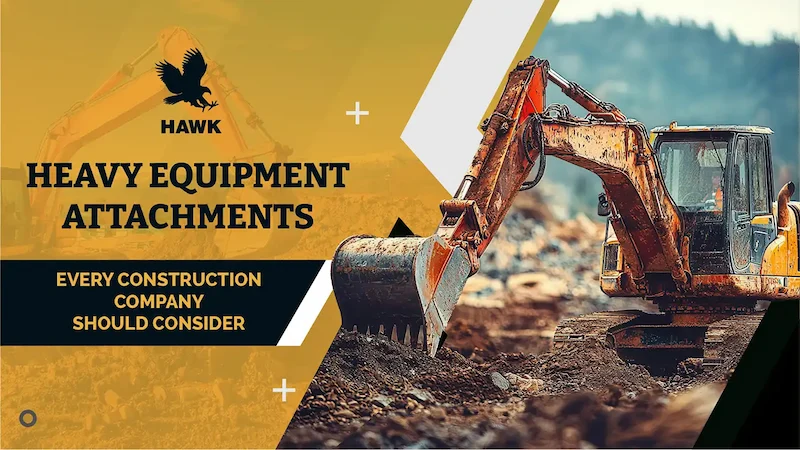Table of Contents
The construction industry relies on heavy equipment to complete projects efficiently and effectively. While the machinery itself is crucial, the right attachments can significantly enhance a company’s productivity, versatility, and safety on the job site. In this guide, we’ll explore everything construction companies need to know about heavy equipment attachments, from their types to their role in modern construction.
Introduction
In construction, the right tools can mean the difference between project success and costly delays. Heavy equipment attachments transform standard machinery into versatile, multi-functional tools that cater to a wide range of tasks. Whether it’s digging, lifting, breaking, or leveling, these attachments offer construction companies the flexibility they need to meet diverse project requirements.
Understanding Heavy Equipment Attachments
Heavy equipment attachments are additional tools or components that connect to machinery, such as excavators, loaders, and backhoes. They allow a single machine to perform multiple functions, reducing the need to invest in separate specialized equipment. Attachments are designed to be compatible with various types of heavy machinery, making them a cost-effective solution for construction companies.
Definition and Types of Attachments
Definition
Heavy equipment attachments are specialized add-ons or tools that enhance the functionality of construction machinery. They are designed to perform specific tasks, enabling equipment to handle a broader range of applications.
Common Types of Attachments
- Buckets: Used for digging, scooping, and material handling.
- Hydraulic Breakers: Ideal for demolition and breaking through concrete or rock.
- Augers: Used for drilling holes in the ground, especially for fencing or foundation work.
- Grapples: Designed for picking up and moving large or irregularly shaped objects.
- Thumbs: Enhance a bucket’s capability to grasp materials securely.
- Blades: Perfect for grading, leveling, and pushing material.
- Forks: Transform loaders into forklifts for material transportation.
How Attachments Enhance Equipment Versatility
Heavy equipment attachments can transform a single machine into a multi-purpose tool, eliminating the need for additional equipment. For example:
- Excavators: When paired with a bucket, they dig trenches; with a breaker, they demolish structures.
- Skid Steers: Equipped with augers, they drill holes; with forks, they move materials.
This versatility improves efficiency, reduces operational costs, and maximizes the return on investment in equipment.
Importance of Strategic Attachment Selection
Choosing the right attachment is critical to project success. Strategic selection ensures:
- Increased Productivity: Attachments tailored to specific tasks improve efficiency.
- Cost Savings: The right attachment reduces the need for renting or purchasing additional machinery.
- Adaptability: Properly chosen attachments enable equipment to handle diverse tasks, keeping operations flexible.
Construction companies must evaluate project needs, equipment compatibility, and attachment features before making a choice.
Essential Attachment Types for Construction Companies
To tackle a variety of projects, construction companies should consider investing in the following essential attachments:
Buckets
- Use Case: Digging, grading, and material handling.
- Types: Trenching buckets, grading buckets, and heavy-duty buckets.
Hydraulic Breakers
- Use Case: Demolition work, breaking concrete, and excavation in rocky terrains.
Augers
- Use Case: Digging holes for fencing, poles, and foundation work.
Grapples and Thumbs
- Use Case: Picking up and moving debris, logs, or large stones.
Quick Couplers
- Use Case: Fast attachment changes, minimizing downtime on job sites.
By having a diverse range of attachments, companies can adapt to various projects and meet client needs efficiently.
Selecting the Right Attachment
Choosing the right attachment involves several considerations:
Project Requirements
Determine the tasks the attachment will perform. For example, demolition requires a breaker, while grading requires a blade.
Equipment Compatibility
Ensure the attachment is compatible with the machine’s size, power, and hydraulic capacity.
Quality and Durability
Invest in high-quality attachments made from robust materials to ensure longevity and reliability.
Ease of Maintenance
Attachments with simple maintenance requirements reduce downtime and extend their lifespan.
Manufacturer Support
Choose attachments from reputable manufacturers that provide customer support, warranties, and replacement parts.
Safety Considerations
Safety is paramount when using heavy equipment attachments. Improper use or attachment failure can result in accidents and project delays. Follow these safety measures:
- Regular Inspections: Check attachments for wear, cracks, or loose connections before use.
- Proper Training: Ensure operators are trained to attach and use the equipment correctly.
- Weight Limits: Avoid exceeding the equipment’s weight capacity to prevent tipping or mechanical strain.
- Secure Coupling: Verify that attachments are securely connected to the machine before operation.
Adhering to these safety practices minimizes risks and ensures smooth operations on the job site.
The Critical Role of Attachments in Construction Companies
Attachments play a pivotal role in modern construction by enabling companies to:
- Improve Efficiency: Reduce project timelines by using the right tools for specific tasks.
- Enhance Profitability: Save on equipment costs by investing in versatile attachments instead of standalone machinery.
- Stay Competitive: Offer a broader range of services to clients with a single machine equipped for multiple functions.
By leveraging attachments effectively, construction companies can streamline operations and increase their market competitiveness.
Conclusion
Heavy equipment attachments are an indispensable asset for construction companies. They enhance versatility, improve productivity, and reduce operational costs, making them essential for meeting the demands of modern construction projects.
By understanding the different types of attachments, selecting them strategically, and adhering to safety protocols, top construction companies are maximizing the potential of their equipment and achieving greater efficiency on job sites. Investing in high-quality attachments not only ensures long-term durability but also positions your company for sustained success in the competitive construction industry.
Equip your machinery with the right tools, and you’ll be well on your way to transforming your construction operations.
Want to explore something different? Protecting Working Professionals from Workplace Injustices: A Practical Guide

